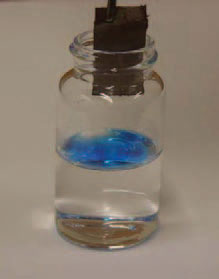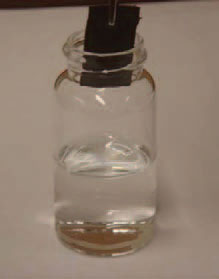| Posted: May 30, 2008 | |
Novel nanotechnology material addresses water pollution and oil spills |
|
| (Nanowerk Spotlight) Advanced material engineering techniques can structure surfaces that allow dynamic tuning of their wettability all the way from superhydrophobic (i.e. repelling) behavior to almost complete wetting (i.e. superhydrophilic or strongly absorbing) - but these surfaces only work with high-surface-tension liquids. Almost all organic liquids that are ubiquitous in human environment such as oils, solvents, detergents, etc. have fairly low surface tensions and thus readily wet even superhydrophobic surfaces. In a previous Spotlight we reported how researchers have been creating surfaces that would extend superhydrophobic behavior to all liquids, no matter what the surface tension ('Nailing' superlyophobic surfaces with nanotechnology). New work coming out of MIT now describes a novel nanostructures membrane that can be switched between superhydrophilic and superhydrophobic behavior on demand. Think of it as an 'oil spill clean-up paper towel' that absorbs only the oil but not the water. Given the global scale of severe water pollution arising from oil spills and industrial organic pollutants, this nanomaterial may prove particularly useful in the design of recyclable absorbents with significant environmental impact. | |
| "There are many materials able to absorb preferentially oil from water, but none has the ability to fully discriminate as our new nanoporous membranes do" Dr. Francesco Stellacci tells Nanowerk. "We have developed a self-assembly method for constructing thermally stable, freestanding nanowire membranes that exhibit controlled wetting behavior ranging from superhydrophilic to superhydrophobic. These membranes can selectively absorb oils up to 20 times the material’s weight in preference to water, through a combination of superhydrophobicity and capillary action. Moreover, the nanowires that form the membrane structure can be re-suspended in solutions and subsequently re-form the original paper-like morphology over many cycles." | |
  |
|
| Oil uptake studies of the silicone-coated nanowire membrane. a, Absorption capacities of the membrane for a selection of organic solvents and oils in terms of its weight gain. A layer of gasoline (left) can be removed by addition of the self-supporting membrane to the gasoline followed by the removal of the paper (right). The gasoline was labeled with Oil Blue 35 dye for clear presentation. (Reprinted with permission from Nature Publishing Group) | |
| Stellacci, Finmeccanica Associate Professor of Materials Science and Engineering at MIT, together with his collaborators from National University of Singapore, NIMS in Japan, and the University of Connecticut, has published the findings of this work in the May 30, 2008 online edition of Nature Nanotechnology ("Superwetting nanowire membranes for selective absorption") | |
| Many methods for fabricating various types of membrane materials for water filtration have limitations for practical use because of the need to withstand harsh conditions, the need for multistep procedures for implementation or limitations in substrate size. New and recyclable membranes, such as the one developed by Stellacci and his team, that overcome these fundamental limitations could significantly reduce materials waste and operating costs. | |
| "The thermally stable membrane material that we developed is based upon self-assembled, free-standing, paper-like structures of cryptomelane-type manganese oxide nanowires" Stellacci explains. "The nanowire membrane, composed of three-dimensional porous nanostructures, exhibits a superhydrophilic character with a wetting time of 0.05 seconds. When coated with a thin layer of hydrophobic molecules, the membrane becomes superhydrophobic, as is made evident by its high water contact angle (> 170°). These two extreme wetting characteristics are completely switchable upon coating with or removal of the hydrophobic molecules at elevated temperatures." | |
| In effect, the researchers have created a surface that repels water while allowing oil to selectively spread. They demonstrated the efficient absorption and high level of selectivity of this superwetting nanowire membrane not only for oil but also for a broad range of organic solvents such as toluene or the highly toxic benzene. | |
| The scientists first synthesized free-standing nanowire membranes of arbitrary size exhibiting a uniform surface morphology. This self-assembled membrane has a pore size distribution centered at 10 nm and a surface area of 44 square meters per gram. The wetting time for a water droplet (∼2 µl) added to the surface was found to be 0.05 seconds. | |
| "To obtain superhydrophobic surfaces, we silicon-coated the membrane using a vapor deposition technique that provides a coating over the entire surface of the porous material" Stellacci describes the process. "As anticipated, the modified membrane becomes superhydrophobic, as is made evident by its water contact angle of 172±1°. We also found that the new material appears to be completely impervious to water – the superhydrophobicity of the silicone-coated membrane remains unaltered after being immersed in water at ambient temperature for more than three months." | |
| An important feature of this nanomaterial is that this hydrophobic coating can be easily removed by heating the nanowire membrane to elevated temperatures (390 °C), resulting in switchable wetting behavior between its superhydrophilic and superhydrophobic states. | |
| The membrane, with a calculated density of 0.286 grams per cubic centimeter, demonstrated uptake capacities up to 20 times its weight for a collection of organic solvents and oil. Stellacci points out that 1 cubic meter of the material could absorb about 14 tons of motor oil (it can selectively absorb emulsified oil suspensions in water with a remarkable uptake capacity of 9 tons per cubic meter) – making it an ideal candidate as oil absorbent. | |
| Furthermore,the membrane can be regenerated after each use by ultrasonic washing and autoclaving (∼130 °C for 20 minutes), making recycling schemes for both the membrane and the absorbed liquid possible. | |
| Although the use of manganese oxide in synthesizing the membranes might pose a potential toxicological hurdle for large-scale use, the design principles used by Stellacci and his collaborators clearly can serve as a blueprint for fabricating other novel nanomaterials that can help address the widespread water pollution problems that many regions are faced with. | |
 By
Michael
Berger
– Michael is author of three books by the Royal Society of Chemistry:
Nano-Society: Pushing the Boundaries of Technology,
Nanotechnology: The Future is Tiny, and
Nanoengineering: The Skills and Tools Making Technology Invisible
Copyright ©
Nanowerk LLC
By
Michael
Berger
– Michael is author of three books by the Royal Society of Chemistry:
Nano-Society: Pushing the Boundaries of Technology,
Nanotechnology: The Future is Tiny, and
Nanoengineering: The Skills and Tools Making Technology Invisible
Copyright ©
Nanowerk LLC
|
Become a Spotlight guest author! Join our large and growing group of guest contributors. Have you just published a scientific paper or have other exciting developments to share with the nanotechnology community? Here is how to publish on nanowerk.com.
